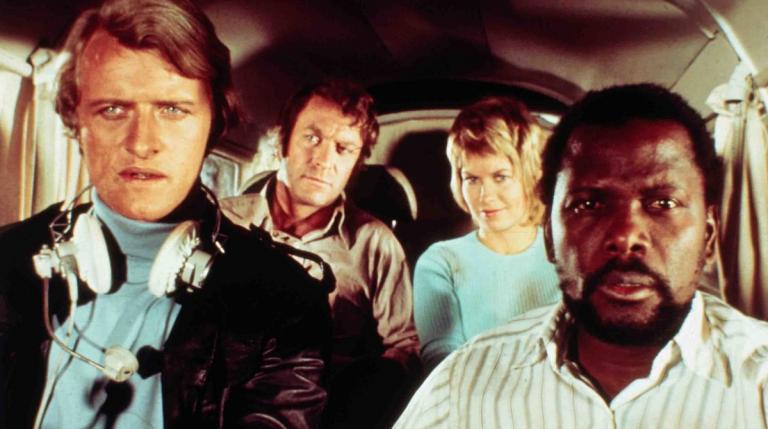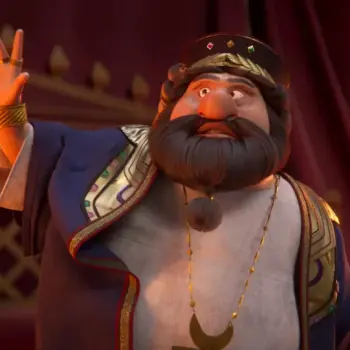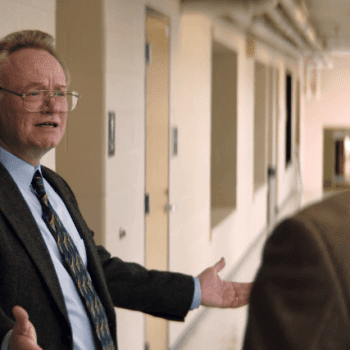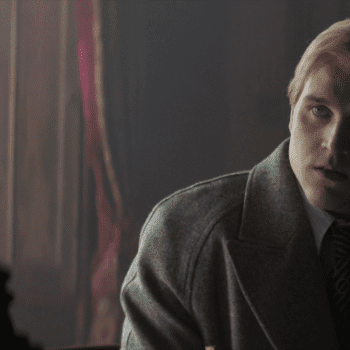The latest in a month-long series of re-posts from my Facebook marathon in April 2020.
–
Sidney Poitier marathon part 17 (1975-1977):
The Wilby Conspiracy (1975) is a sort of political thriller in which Sidney Poitier plays a South African revolutionary, newly released from prison, who, for various reasons, finds himself running from the law with his lawyer’s English boyfriend, played by Michael Caine.
It’s a little like 1958’s The Defiant Ones, inasmuch as Poitier is a fugitive making his way through a racist society (Jim Crow there, apartheid here) with a white man he has never met before and with whom he doesn’t get along particularly well. Poitier is even wearing handcuffs at first (which he removes, in a rather tense scene, with the help of a machine that could very easily cut through his arms if he isn’t careful), but at least he is not shackled to the white man this time.
The gist of this film is that Poitier and Caine have to make it across the border to Botswana, where the leader of Poitier’s movement is hiding, and along the way they also have to retrieve some diamonds. But the two of them are being pursued by a ruthless policeman (played by Nicol Williamson, who went on to play Merlin in 1981’s Excalibur) who gets several opportunities to articulate the racist rationale behind his government’s policies.
A few quick points:
— The main characters have to endure some indignities along the way. At one point, because Poitier’s hands are cuffed and his fingers are numb, Caine has to undo Poitier’s zipper and help him pee. (We don’t actually see the latter action, which is fine by me.) Meanwhile, Caine’s girlfriend — the lawyer — is subjected to a couple of humiliating strip searches offscreen and the police walk in on her and Caine while the two of them are in the bathtub together and she has to sleep with a guy in order to get him to fly them all across the border and she drives a Jeep in her underwear to distract the authorities while the men are going somewhere else… and by the end of the film, she really doesn’t seem to be registering any more just how much crap the movie has put her through.
— Poitier’s character says he went to a missionary school and, “instead of Mark and Luke, I discovered Marx and Lenin.” And so this film alludes to the Communist influence on African post-colonial politics, just as 1973’s A Warm December did.
— An Indian dentist comments at one point, “I’ve gone metric.” The metric system was first proposed in France in the 1790s, but I do recall that its widespread usage (here in Canada, at least, and thus perhaps in other parts of the Commonwealth) seemed to be something new-ish when I first went to school in the 1970s. I heard people talking about imperial-to-metric conversions back then a lot more than I do nowadays, at least.
— The racial tension in this film is not just between black and white; an Indian character says her people will be the losers if the black population of South Africa ever rises up against the white population. This is reminiscent of how 1972’s Buck and the Preacher acknowledged the fact that black and Native Americans in the 19th century had reason to distrust not just the white Americans but each other as well.
— Poitier gets top billing over Michael Caine. Poitier was the more well-established star at the time, but had taken second billing to other actors so frequently in his career I felt it was worth noting this. For what it’s worth, it was not uncommon for Caine to take second billing at this point in his career, e.g. behind Sean Connery in 1975’s The Man Who Would Be King, behind Laurence Olivier in 1972’s Sleuth, etc.
— This movie marked the first time that Poitier had played a modern-day African since 1957’s Something of Value (set in Kenya) and The Mark of the Hawk (possibly set in a fictitious country, but filmed partly in Nigeria); prior to that, he had played a South African in 1951’s Cry the Beloved Country. He also played ancient or medieval North Africans in 1964’s The Long Ships and 1965’s The Greatest Story Ever Told.
— This movie marks the English-language debuts of Persis Khambatta (who went on to play Ilia in 1979’s Star Trek: The Motion Picture) and Rutger Hauer (who went on to star in 1982’s Blade Runner and many other films).
— The only other movie to co-star Michael Caine and Rutger Hauer is 2005’s Batman Begins, which was made three decades after this film — and The Wilby Conspiracy even has a scene in which bats fly at Caine while he’s going down into a sinkhole!
— Poitier has a love scene in a closet with Khambatta which might be the sexiest scene of his entire filmography, at least up until now — though the nudity is implied, not graphic.
— Reunions: The film is directed by Ralph Nelson, who previously directed Poitier in 1963’s Lilies of the Field and 1966’s Duel at Diablo (the former of which won Poitier his Oscar for best actor). This was the last time Poitier worked for a director other than himself for over a dozen years.
Poitier’s next two films reunited him with Bill Cosby, and while Wikipedia says that these films were “sequels” to 1974’s Uptown Saturday Night, they aren’t, really. For one thing, the characters have different names, and there are no references to the events of the earlier movies.
Admittedly, Let’s Do It Again (1975) does cast Cosby and Poitier in very similar roles, right down to their clothing and hairstyle fashions. Even the title seems to suggest that this film is an extension of the earlier film. But the similarities between the characters are more akin to how comic duos like Laurel & Hardy or Bob Hope & Bing Crosby used to work together in movie after movie while playing different people. Same character types, sure. Same characters, not so much.
This time, the story hinges on Poitier’s ability to rig boxing matches by hypnotizing the fighters. He and Cosby do this once to raise money for their Afrocentric fraternal lodge, the Sons and Daughters of Shaka, but when the powers behind the boxing matches realize what these two men have done, they force Poitier and Cosby to rig another match or two.
A few quick points:
— The first boxer who is hypnotized by Poitier is played by Jimmie Walker, whose sitcom Good Times premiered one year earlier in 1974.
— The 1990s rapper Biggie Smalls (who went on to be known as The Notorious B.I.G.) took his name from one of the characters who manipulates Cosby and Poitier in this film.
— I don’t recall Cosby doing anything particularly lascivious in Uptown Saturday Night, but in this film he leers at a couple of women, and in one case he is so distracted he crashes a forklift. Incidentally, Cosby’s character is married, and in another scene, he and his wife openly talk about how horny they are while eating at a restaurant with Poitier and his wife, the latter of whom objects to the topic of their conversation.
— This time in LGBT references: One of the fight organizers uses the phrase “college-educated faggots”. That makes this the third Poitier film to use this epithet, following 1961’s A Raisin in the Sun (which similarly linked the f-word to college education) and 1967’s To Sir, with Love (where it’s not clear how we’re supposed to feel about the person who uses the f-word).
— Reunions: The leader of the fraternal lodge is played by Ossie Davis, who was in 1950’s No Way Out with Poitier, and whose wife Ruby Dee was also in that film and in five other films with Poitier. (Ossie Davis also took over the lead role in the stage version of A Raisin in the Sun after Poitier went back to Hollywood.)
Poitier’s next collaboration with Cosby was A Piece of the Action (1977), which doesn’t even look like a sequel to the other two Poitier-Cosby films. Cosby is clean-shaven in this film, for one thing, and this time he and Poitier play well-to-do, well-dressed thieves rather than the working-class blokes they played in the first two films.
In this film, James Earl Jones plays a retired cop who knows a lot about Poitier and Cosby’s crimes but, instead of turning them over to the authorities, he uses this information to blackmail them into volunteering at a community centre for young black people who need help applying for jobs.
Naturally, the kids here are rowdy, and Cosby and Poitier chafe at having to work with them, but by the end of the film, everyone has learned a thing or two and become a better person, and everyone is dancing together in the classroom as the kids graduate and the closing credits play.
The film basically plays like a hybrid of the earlier Poitier-Cosby con-man films and Poitier’s even earlier role-model films, especially To Sir, with Love. There is even a scene in which Poitier teaches his students the value of dignity by getting them to talk to strangers on a sidewalk, which he will do again a couple decades later in 1996’s To Sir, with Love II.
There are some noteworthy differences between this film and To Sir, with Love, though. For starters, Poitier actively kicks a student to the floor in his very first classroom session, just to teach him a lesson, which the Poitier of that other film would never do. Also, one girl stands up in class and chews out a female teacher for being a “bourgeois” type who exploits “ghetto” kids, and she is a lot more articulate, and given a lot more time to make her point, than any student in the other film.
But it’s interesting to see how this film brings together different strands of Poitier’s filmography — not least because this was the last film that Poitier would act in for over a decade. This was the note that the classic movie-star phase of his career ended on, essentially. And it ended by putting a new socio-political spin on one of his most iconic personae.
A few other quick points:
— This film came out two years after Poitier’s previous film, which made 1976 the first year without a single new Poitier film since 1953. The gaps got even longer after this: He wouldn’t direct another film until 1980, and he wouldn’t act in another film until 1988.
— Poitier was 50 when this film came out, but I don’t believe his character’s age is ever specified. His character is living with a woman who is about to celebrate her 29th birthday (and her parents complain that she and Poitier are “living in sin”).
— In one scene, a waiter brings a table to the phone and plugs it into a phone jack in a nearby post. I love these glimpses of how technology used to be used.
— This is the first film to star one of Poitier’s children, i.e. Sherri Poitier, who was 21 at the time. I am still not sure which character she played, but she appears last in the credits, as someone named “Cookie”. She doesn’t have any other acting credits at the IMDb, though a few of her siblings do; her half-sister Sydney has been the most active onscreen, and appeared in the 1999 miniseries Noah’s Ark and the Quentin Tarantino film Death Proof (which was part of 2007’s Grindhouse), among other things. Poitier’s older brother Cyril also appears in this film (and in Uptown Saturday Night).
— The creepiest Cosby moment yet in a Poitier film: A woman comes up to Cosby out of the blue at a nightclub, while his date is in the bathroom, and says, “If you don’t dance with me, Imma hollar rape.” Cosby: “Is that a request?” Woman: “What, the rape or the dance?” Cosby: “Don’t make no never mind to me.” Woman: “Don’t make no never mind to me, neither!” And then they dance.
— This time in LGBT references: This might not be a reference, but when the one girl chews out her female teacher in class, she says at one point that the teacher needs a man “or someone”, and the teacher breaks down in tears and says that the girl has no right to imply such untruths. Is the teacher responding specifically to the insinuation that she might need a lover of either sex, or is she responding to some other part of the girl’s tirade? It wasn’t clear to me, at any rate, but this did some like one plausible interpretation of their exchange.
— Reunions: This film and Let’s Do It Again were both scored by Curtis Mayfield, who famously wrote the music for the 1972 blaxploitation film Super Fly. This is also the first film to co-star Poitier and James Earl Jones; they would both go on to be part of the ensemble in 1992’s Sneakers. (This film came out the same year that Jones began providing the voice of Darth Vader in the Star Wars movies, and it came out the same year he played one of the Magi in Franco Zeffirelli’s Jesus of Nazareth.)
–
The image above shows Rutger Hauer, Michael Caine, Prunella Gee and Sidney Poitier in The Wilby Conspiracy.














